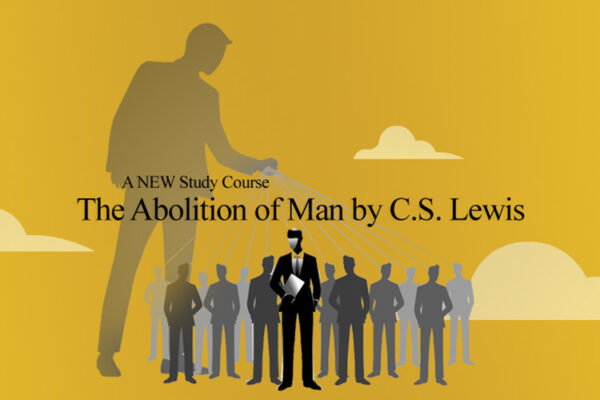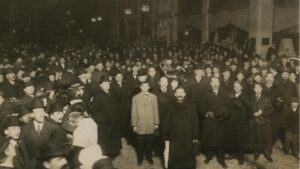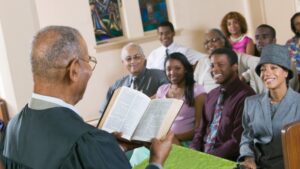Back to series


Great Evangelists of a Golden Era
Click here to open a Print - Friendly PDF
The tall massive man with the hypnotic eyes bent low over his pulpit. “You who are now willing,” he said, “to pledge to me and to Christ that you will immediately make your peace with God, please rise up.... You that mean that I should understand that you are committed to remain in your present attitude, not to accept Christ—those of you that are of this mind may sit still.”
The people looked at one another in stunned amazement. Here was a man demanding an immediate decision. They had been brought up to believe that if you were one of the elect, the Holy Spirit would convert you. If you weren’t, there was nothing you could do to help yourself.
The preacher had more to say. “Then you are committed.” “You have taken your stand. You have rejected Christ and His Gospel.... You may remember as long as you live that you have thus publicly committed yourselves against the Savior and said, ‘We will not have this Man Christ Jesus to reign over us.’”
 This was too much. Faces reddened. Women’s bonnets bobbed in indignation as they turned to their neighbors with a “Well, I never—” With one accord they started for the door. The preacher spent the next day in fasting and prayer. Rumors reached him that he was going to be tarred and feathered. But when meeting time arrived, businesses shut down, stores closed, bowlers left their games on the village green. Everyone headed for the meetinghouse.
This was too much. Faces reddened. Women’s bonnets bobbed in indignation as they turned to their neighbors with a “Well, I never—” With one accord they started for the door. The preacher spent the next day in fasting and prayer. Rumors reached him that he was going to be tarred and feathered. But when meeting time arrived, businesses shut down, stores closed, bowlers left their games on the village green. Everyone headed for the meetinghouse.
Young Charles G. Finney’s unusual method of preaching had worked. It was the beginning of a revival at Evans Mills, New York, in 1824. And, it was the beginning of an era when “the absorption in the welfare of the soul” rose to an unprecedented pitch in American history.
The nineteenth century was the golden age for evangelical Christianity in America. It began with the far-reaching Revival of 1800. Though there was a waning of religious fervor in the early 1820s, by the 1830s revivals had become part and parcel of American life.
A period of spiritual drought in the 1840s was ended by the remarkable Revival of 1857-58. After the Civil War, the revival spirit again came to the front.
During the nineteenth century, evangelists carried revival brands from generation to generation— men like Peter Cartwright, Asahel Nettleton, Lyman Beecher, James Caughey, and Jacob Knapp. But overshadowing all others were two men: Charles G. Finney and Dwight L. Moody.
“Heathen” Studies Law
Charles G. Finney spent his boyhood in the frontier country of New York. He was, as he admitted later, “almost as destitute of religion as a heathen.” Yet, when he went to Adams, New York, to study law, he linked up with a Presbyterian church and listened attentively to the sermons of the minister, the Rev. George W. Gale. He even directed the choir. But he was not a Christian.
It was in 1821 that Finney was dramatically converted. He got interested in the Bible through references to the Mosaic laws in his legal books. He bought a Bible and through reading it became intellectually convinced of the truth of Christianity. But the question remained—should he become a Christian?
One autumn morning he was on his way to his office when he was stopped in his tracks by an inward voice which seemed to say, “Will you accept it now, today?” Instead of going to his office he went off into the woods. Reaching a spot where he thought no one would see him, he knelt down.
He tried to pray but could not. He was just about to give up when he heard a rustling and looked up in alarm to see if someone had discovered him. Suddenly, he realized how great was his pride. Remembering the words of Scripture, “Then shall ye seek me and find me, when ye shall search for me with all your heart,” he cried out, “Lord, I take Thee at Thy Word.”
 Finney left the woods in a lighthearted mood. He didn’t quite understand what had happened to him. That evening in the back of his law office he was overcome with a sense of unutterable ecstasy. He later wrote: “The Holy Spirit descended upon me in a manner that seemed to go through me, body and soul. I could feel the impression, like a wave of electricity, going through and through me. Indeed it seemed to come in waves and waves of liquid love; for I could not express it in any other way. It seemed like the very breath of God. I can recollect distinctly that it seemed to fan me, like immense wings.”
Finney left the woods in a lighthearted mood. He didn’t quite understand what had happened to him. That evening in the back of his law office he was overcome with a sense of unutterable ecstasy. He later wrote: “The Holy Spirit descended upon me in a manner that seemed to go through me, body and soul. I could feel the impression, like a wave of electricity, going through and through me. Indeed it seemed to come in waves and waves of liquid love; for I could not express it in any other way. It seemed like the very breath of God. I can recollect distinctly that it seemed to fan me, like immense wings.”
Finney dropped his law studies the next day and went about the town telling what the Lord had done for him. A revival began immediately.
After studying theology with his pastor, Finney was commissioned by a women’s missionary society to preach in western New York. Beginning with Evans Mills, town after town experienced revival.
While preaching at Evans Mills, Finney took time out to be married. After “a day or two” he left his wife in Whitestown to go back to Evans Mills, intending to return in a week with a rig to carry their household effects. As it turned out, he was gone six months, for he found little revivals popping all around Evans Mills. He felt he could not take the time that winter to get his wife.
Early in the spring, however, he set out in horse and cutter for Whitestown. On the way he had to stop to have his horse shod; the people of the town pounced on him and begged him to preach. He did so, and a revival started. Someone else had to be sent to fetch Finney’s wife.
Wherever he went people turned out en masse. He preached out of doors, in barns and in schoolhouses. Men left their plows in the fields to come to the meetinghouse in work clothes. Invariably Finney’s sermons were followed immediately by confession, repentance, tears, and many conversions.
“Promoting” Revivals
Finney didn’t believe in sitting supinely waiting for God to send a revival. He set out to promote revivals; he believed God wanted him to do this.
In one town he found the meetinghouse locked up. He persuaded a woman to let him use her parlor for a meeting at which he preached to thirteen people. Next, he got permission to use the schoolhouse on Sunday.
In the meantime, he walked around the village and was horrified at the cursing and swearing. The atmosphere, he said, “seemed to me to be poison.” On Sunday, however, the schoolhouse was full. Finney berated the townspeople for their profanity. He told them they seemed “to howl blasphemy about the streets like hell-hounds.” At first angered, the people soon began to confess their sins. The man who had locked the meetinghouse gave in and gave Finney the key. A revival was underway.
A spirit of prayer marked every Finney revival. Converts prayed all night for others. When Finney was in town, it was common for Christians whenever they met to fall on their knees in prayer. Finney assured people that God would answer prayer if they fulfilled the conditions upon which He promised to answer prayer.
Finney himself depended utterly on prayer. He said, “Unless I had the spirit of prayer I could do nothing. If even for a day or an hour I lost the spirit of grace and supplication, I found myself unable to preach with power and efficiency, or to win souls by personal conversation.”
During the winter of 1828-1829 Finney was in Philadelphia. A number of lumbermen who had come down the Delaware River on rafts of lumber were converted. They went back into the wilderness where there were no schools, no churches, no ministers, and touched off a backwoods revival in which 5,000 people were converted.
 The next year Finney conducted a revival in Rochester, New York, during which 1,000 persons were converted. Within another year or so 1,500 towns and cities were affected.
The next year Finney conducted a revival in Rochester, New York, during which 1,000 persons were converted. Within another year or so 1,500 towns and cities were affected.
In 1832 Finney was called to a pastorate in New York City and while there organized the Broadway Tabernacle. It was only ten years since Finney had been touched by God and had gone out to turn towns upside down. He ought to have been well satisfied.
Instead, Finney was troubled. His health was beginning to break. It seemed that the revivals were falling off. “Perhaps my work is coming to an end,” Finney thought. He decided to take a voyage to the Mediterranean.
On the way home he was beside himself. He prayed night and day and paced restlessly on deck. At length, “After a day of unspeakable wrestling and agony in my soul, just at night, the subject cleared up to my mind. The Spirit led me to believe that all would come out right and that God had yet a work for me to do; that I might be at rest; that the Lord would go forward with His work, and give me strength to take any part in it that He desired.”
God did indeed have much more for Finney to do. Back in New York he gave a series of lectures on revivals. These were later published as Finney’s Lectures on Revival. Twelve thousand copies were sold as fast as they could be printed. They were translated into several languages. A London publisher sold 80,000 volumes, and the lectures were instrumental in promoting revivals in England, Scotland, Wales, and Canada.
Soon after this, Finney accepted the professorship of theology at Oberlin College in Ohio, later becoming president. He continued with evangelistic work and made two visits to London, where as many as 1,500 persons at a time attended his inquiry meetings. He served at Oberlin to within a few weeks of his death in 1875.
What was the strength of Finney’s preaching? Other evangelists believed ministers should not try to “get up” a revival. Preach the Gospel, they said, and depend on the Holy Spirit to bring about an awakening.
An Immediate Verdict
Finney appealed for an immediate verdict for Jesus Christ. He directed his sermon to each hearer personally. He had no patience with preachers who preached “about other people and sins of other people, instead of addressing them and saying, ‘You are guilty of these sins,’ and ‘The Lord requires this of you.’”
Finney did not agree with the “Old School” Presbyterian view that man was unable to do anything about his salvation but could only wait for the Holy Spirit to give him a new heart. No, said Finney. Salvation is for everyone, for the “whosoever.” A man has free will to accept or to reject Christ. True, it was the work of the Holy Spirit to convict sinners (often through a preacher), but in the end, the sinner had to take the step of faith.
Finney was severely criticized for certain “new measures” he put into use in his revivals. He prayed for sinners by name. He introduced the “anxious seat,” a bench in the front of the church to which people who were in the struggle of rebirth were invited. He permitted women to pray in public. He spoke in everyday language. He used assistants to speak to people about their soul’s welfare. All these things were highly irregular.
While a pastor in New York, Finney became convinced through studying the Bible that “an altogether higher and more stable form of Christian life was attainable, and was the privilege of all Christians.”
He preached his doctrine of “entire sanctification” at Oberlin College, although he did not profess to have found the experience he advocated for some years. To Finney “perfection” meant perfect trust and consecration which could enable a Christian to live without “known sin.” It did not mean freedom from troublesome physical and mental appetites or from error and prejudice.
Unfortunately, Finney lived to see this doctrine carried to extremes. By 1857 he was denouncing those who “having begun in the Spirit ... try to become perfect in the flesh.”
Charles G. Finney might be called the father of modern evangelism. Many owe a debt to him for his pioneering in the task of promoting revivals. One of these was a man whose labors began when Finney’s work was coming to a close—the great evangelist of the cities, Dwight L. Moody.
 In 1856 a stocky young man from Northfield, Massachusetts, arrived in Chicago seeking to make a fortune of $100,000. Soon he was well on his way to his goal as a successful shoe salesman. But something happened to change the direction of his life.
In 1856 a stocky young man from Northfield, Massachusetts, arrived in Chicago seeking to make a fortune of $100,000. Soon he was well on his way to his goal as a successful shoe salesman. But something happened to change the direction of his life.
After working hard all week as a traveling salesman, Moody (who had been converted at the age of seventeen by his own Sunday school teacher) was superintending a Sunday school he had built up from a class of boys.
One day a fellow teacher came to him. He was deathly ill. He told Moody he was going home to die, but he was troubled because he had never led any of the girls in his class to Christ.
Moody consented to go with the teacher to visit each girl. For the first time Moody prayed for the salvation of a person, and his prayers were answered. One by one the girls were converted. Moody called the girls of the class together for a prayer meeting on the night before the teacher was to leave. The touching prayers of the girls greatly affected Moody.
God Kindles a Fire
He said later: “God kindled a fire in my soul that has never gone out. The height of my ambition had been to be a successful merchant, and if I had known that meeting was going to take that ambition out of me, I might not have gone.”
Shortly thereafter Moody gave up his job to devote himself fully to the Lord’s work. When a speaker failed to show up at a Sunday school convention, he undertook his first public exhortation; over sixty were converted. He was active in YMCA work. During the Civil War, he did chaplain work at Camp Douglas, just south of Chicago. He carried on his regular Sunday school work. And he started Sunday evening services.
In 1867 he went to England to hear the great preacher Spurgeon. There he met young Henry Moorehouse, “The Boy Preacher,” who returned to America with him and gave a series of sermons at Moody’s church on God’s love.
For six straight nights the young man preached on the same verse: John 3:16. He went through the Bible from Genesis to Revelation to prove that in all ages God loved the world.
Moody’s reaction: “I never knew up to that time that God loved us so much. This heart of mine began to thaw out; I could not keep back the tears. It was like news from a far country; I just drank it in.”
 Moody’s preaching changed. “I used to preach that God was behind the sinner with a double-edged sword ready to hew him down. I have got done with that. I preach now that God is behind him with love, and he is running away from the God of love.”
Moody’s preaching changed. “I used to preach that God was behind the sinner with a double-edged sword ready to hew him down. I have got done with that. I preach now that God is behind him with love, and he is running away from the God of love.”
Henceforward Moody was to be an expositor of Scripture.
Moody realized how inadequate he was in education and experience for the task of preaching. Yet by 1865 he was pastor of his own church on Illinois Street. Two women used to sit in his meetings in the front row. He could see by the expressions on their faces that they were praying.
At the close of the services they would say to him: “We have been praying for you.” “Why don’t you pray for the people?” Moody would ask. “Because you need the power of the Spirit,” they said.
Moody Seeks Power
Moody said years after: “I need the power? Why, I thought I had power. I had the largest congregations in Chicago and there were many conversions. I was in a sense satisfied.” The women kept right on praying, and Moody was filled with a great heart hunger.
While Moody was in this agitated condition, the great Chicago Fire laid the city in ashes, destroying his church and his home. Afterward he went to New York to raise money for a new church. While there he had the crowning spiritual experience of his life.
Moody only said this about it: “My heart was not in the work of begging. I could not appeal. I was crying all the time that God would fill me with His Spirit. Well, one day in the city of New York—oh, what a day! —I cannot describe it, I seldom refer to it; it is almost too sacred an experience to name. Paul had an experience of which he never spoke for fourteen years. I can only say that God revealed Himself to me, and I had such an experience of His love that I had to ask Him to stay His hand. I went to preaching again. The sermons were not different; I did not present any new truths, and yet hundreds were converted.”
Moody was unprepared for the result of his rededication. He went to England in June of 1872, not intending to do any evangelistic work. However, the pastor of a North London church persuaded him to preach on a Sunday. To Moody, the morning service seemed dead and cold. But at the evening service a hush came upon the people. Moody couldn’t understand it. When he asked all who would like to become Christians to rise that he might pray for them, it seemed as if the whole audience was standing.
Moody said to himself: “These people don’t understand me. They don’t know what I mean.” To make sure, he asked them to go to the inquiry room. Everyone who had stood filed into the inquiry room. Again Moody asked them to rise if they really wanted to become Christians. They all got up again. Not knowing what to do, Moody told all who really were in earnest to meet with the pastor the next night.
Moody left London, but on Tuesday he received an urgent message to return to the church. In the Monday evening meeting there had been more inquirers than on Sunday! Moody went back and held meetings for ten days. As a result 400 people were taken into the church.
He found out later that the way had been prepared by a bedridden woman who had been praying for revival in the church. She had read about Moody in the newspaper and asked God to send him to her church. Moody believed that it was this revival that carried him back to England the next year with a singing partner, Ira D. Sankey.
They took England and the British Isles by storm. When they returned to America, a revival started in Brooklyn. Five thousand people filled the building three times a day. In Philadelphia 13,000 heard them in each meeting. For ten weeks they held forth in New York City while 500 ushers tried to handle long lines of people trying to get into the Hippodrome.
Like Finney, Moody was a man of prayer; and he believed prayer was necessary to revival. At one of his Hippodrome meetings in New York, Moody said, “Now, won’t a thousand of you Christians go into the Fourth Avenue Hall and pray for this meeting and let those outside have your seats?” Only a few left.
“Not half enough,” Moody said. “I want a great many more to go out. I see many of you here every night, and if I knew your names I’d call you out.” Moody was often disturbed because Christians occupied seats he thought sinners should fill.
Prisoner Converted
Boston, Chicago, Cleveland, St. Louis, Denver, San Francisco—everywhere Moody went throngs gathered to hear him and thousands were converted. In St. Louis a notorious prisoner was converted through reading one of Moody’s sermons in a newspaper.
When Moody died in 1899, he left behind lasting monuments—a girls’ school in Northfield, a boys’ school at Mount Hermon, and his Bible institute in Chicago. But even more important, he left a spiritual monument in an estimated one million souls won to
the kingdom of God.
Other evangelists followed Moody—Reuben Torrey, Wilbur Chapman, B. Fay Mills, Sam Jones, George Stuart, W. E. Biederwolf, and Billy Sunday.
How would you compare Finney and Moody? Finney was better educated, perhaps intellectually superior, certainly more influential in the field of theology. Moody never pretended to be a great preacher. He told a newspaperman, “I am the most overestimated man in this country. For some reason the people look upon me as a great man, but I am only a lay preacher, and have little learning.”
Still, they both spoke in the everyday language of the common man. They spoke so that the least educated could understand the Gospel. They both avoided controversies and discouraged sectarianism. They both depended upon prayer. Most important, they were both consumed with a love for Christ and a zeal to bring men and women to a knowledge of Him.
 In every age revivals have been scorned, derided, condemned. The revival spirit of the nineteenth century was blamed for causing controversies and divisions among Christians, of fostering confusion and disorder in worship, of being responsible for doctrinal heresies.
In every age revivals have been scorned, derided, condemned. The revival spirit of the nineteenth century was blamed for causing controversies and divisions among Christians, of fostering confusion and disorder in worship, of being responsible for doctrinal heresies.
These criticisms cannot be answered by denying them—for there is an element of truth in each one. Yet they can be countered with facts—agreed to by historians. The revival spirit of the century made Christian liberty, Christian equality, and Christian fraternity the passion of the land. Slavery, poverty, and greed were attacked as never before. Home and foreign mission efforts, Christian philanthropy, moral reform became the concern of almost every converted soul.
Though it was true that the nineteenth century saw schisms in churches and the multiplication of sects, it also saw a tremendous growth in the church as a whole. At the beginning of the century one in sixteen persons in the United States was a church member; at its close one out of every four belonged to evangelical Protestant churches.
Too Much Emotion?
Undoubtedly the chief criticism leveled at revivals is that they overemphasize the emotional and underestimate the rational element in religious experience.
True, Christians were emotional about religion in the nineteenth century; they were called the “sentimental years.” But in the twentieth century the pendulum swung the other way. Critics—in the church as well as without—embalmed revivalism, buried it and sat on its gravestone. Emotion was all but squeezed out of religion in the denominations that once vigorously promoted revivals.
But emotion had not been squeezed out of mankind. Men found an outlet in wars, crime, adulation of popular entertainers, in the pursuit of material success and in the pleasures of the senses.
The pendulum is swinging back. Once again many are seeing that religion must be personal and individual or it is not true religion at all. The words Jonathan Edwards wrote in defense of the Great Awakening more than two centuries ago are just as true today: “True religion is a powerful thing…a ferment, a vigorous engagedness of the heart.”
Revivals have accomplished what God placed His Church into the world to accomplish—they have brought countless numbers of men and women into a personal relationship with Jesus Christ. That is justification enough.
 In the 2004 issues of Knowing & Doing, the account of one of America’s great revivals will be featured, drawn from the republished accounts included in Bethany House’s America’s Great Revivals.
In the 2004 issues of Knowing & Doing, the account of one of America’s great revivals will be featured, drawn from the republished accounts included in Bethany House’s America’s Great Revivals.
 COPYRIGHT: This publication is published by C.S. Lewis Institute; 8001 Braddock Road, Suite 301; Springfield, VA 22151. Portions of the publication may be reproduced for noncommercial, local church or ministry use without prior permission. Electronic copies of the PDF files may be duplicated and transmitted via e-mail for personal and church use. Articles may not be modified without prior written permission of the Institute. For questions, contact the Institute: 703.914.5602 or email us.
COPYRIGHT: This publication is published by C.S. Lewis Institute; 8001 Braddock Road, Suite 301; Springfield, VA 22151. Portions of the publication may be reproduced for noncommercial, local church or ministry use without prior permission. Electronic copies of the PDF files may be duplicated and transmitted via e-mail for personal and church use. Articles may not be modified without prior written permission of the Institute. For questions, contact the Institute: 703.914.5602 or email us.
-
Recent Podcasts
Ralph Waldo Emerson’s Philosophy and Influence
by David George Moore on July 26, 2024Ralph Waldo Emerson was a gifted nineteenth century...Read More
-
The Side B Stories – Nate Sala’s Story
by Jana Harmon, Nate Sala on July 19, 2024
-
Terrorism Through the Eyes of Faith
by Dennis Hollinger on July 12, 2024
-
Recent Publications
Hasn’t Science Proven That Belief in God Is an Outdated Superstition?
by Sharon Dirckx on July 1, 2024Many assume that scientific practice and belief in...Read More
-
Has the Bible Been Corrupted as Some Muslims Claim?
by Andy Bannister on June 1, 2024
-
Seeing Jesus Through the Eyes of Women
by Rebecca McLaughlin on May 15, 2024
0
All Booked
0.00
All Booked
0.00
All Booked
22194
C.S. Lewis’s The Abolition of Man Live Online Small Group 8:00 PM ET
https://www.cslewisinstitute.org/?event=c-s-lewiss-the-abolition-of-man-study-course&event_date=2024-10-02®=1
https://www.paypal.com/cgi-bin/webscr
2024-10-02

Next coming event
Days
Hours
Minutes
Seconds
C.S. Lewis’s The Abolition of Man Live Online Small Group 8:00 PM ET
On October 2, 2024 at 8:00 pmSpeakers

C.S. Lewis Institute
Author





